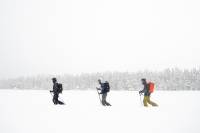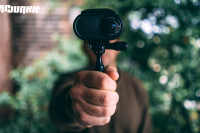How To Bring Camera On The Slopes

Ski Photography: How to Carry a Camera While Skiing or Snowboarding
Above photograph credit: Arc'teryx
Skiing and snowboarding are eye-catching activities for photography. But it'south tricky to carry an expensive camera with you on the wet and cold slopes. Utilize one of these five methods to carry a camera while skiing to get the perfect powder shot.
"If you're going to drop into this gradient, y'all tin can't fall," a ski guide instructs me. "Yous need to be confident enough to ski this and ski information technology well." We're standing on the lip of a mid-30-degree slope that is avalanche-prone. Of course I want to ride it!
I drop in. And well-nigh immediately, my camera bag flies off. Now I have to play rescue with my camera on an avalanche-decumbent slope. Not to mention everyone is watching.
Halfway down the slope, I ride up side by side to the somersaulting photographic camera bag, pick it upwards, and comport it to the base of operations of the run. Catastrophe aside, I had a blast snowboarding that line.
But the episode left me wanting a more than reliable manner to behave my photographic camera while skiing and snowboarding.
Over the class of many winters, I've spoken to ski professionals and professional photographers for brands big and small to learn how the pros comport a photographic camera while skiing.
5 Ways to Behave Your Camera While Skiing
ane. Conventional Carry: Camera Haversack
During the Arc'teryx Backcountry University in Jackson, Wyo., three other apprentice photographers and I spent a day shooting Arc'teryx athletes with Angela Percival, the brand's senior outdoor photographer. It was an incredible experience (and open to the public). Nosotros spent the whole day setting up shots, telling athletes exactly where to slash or leap.
With walkies, we told the athletes to drop in at specific times when nosotros were ready. The photos that resulted were platonic, and we had plenty of fourth dimension to set the composition prior to the subject inbound the frame.
The majority of photographers on this tour, in addition to Percival, used a conventional camera backpack to carry their cameras.
"I utilize a haversack 100 percent of the time. Specifically, an F-End backpack with a rear-entry zip combined with an ICU insert for quick, easy access to all of my camera gear," said Percival.

"I might be alone in not carrying it on my body, but seeing as I work for Arc'teryx, I shoot in a lot of bad (think wet, snowy, cold, frozen, foggy, damp, humid) weather. And then keeping the camera protected inside a purse versus out on my shoulder strap or hip belt getting wet or frozen is my top priority," said Percival. "I've besides mastered the ninja move of getting the camera out of the pack in mere seconds, even when it'southward on my back."
For optimal camera protection and photoshoots where you have time to ready shots, the conventional backpack acquit works best.
2. Quick Capture: Shoulder Clip Carry
"Basically, a camera in your pack is one you're less likely to use," begins Kyle Frost, lensman and creative managing director for The Outbound.
Frost's comport style commencement struck me during a Pursuit Series upshot at Berthoud Pass in Colorado terminal twelvemonth. He kept the camera on his shoulder strap the whole day. And the resulting images were candid and precipitous.
"Having the photographic camera super attainable on the prune makes it easier to have a run-and-gun fashion in the backcountry, and grab more candid/quick moments," said Frost. "Plus, no one really likes waiting for photographers to get their shit together, no matter how adept the pics turn out. Especially on a pow solar day."
Frost recommends the Peak Designs Capture Prune for camera carry. He calls it the aureate standard.

"If you've never used one before, it will change the way you shoot. I primarily shoot with the Sony a7rii or a6300 while skiing," Frost said. "And the pocket-sized form factor/weight on the mirrorless cameras makes it pretty easy to accept it on my backpack strap without besides much discomfort."
Not surprisingly, you won't desire to fall with the camera on the clip. If you've got a mellow mean solar day of skiing ahead of you, or don't fall often, this carry method enables photographers speedy access to candid photos.
three. Fast Shots & Protection: Waterproof Hip Pack

Absolutely, afterward I dropped into the line and played rescue with my fanny pack, I didn't switch upward the carry method. I just got a new hip pack. It was the clip that bankrupt.
A hip pack enables me quick access to my camera during outdoor activities. I can shoot friends and subjects in their natural habitat for the near part — which is what I'grand after.
The hip pack carry isn't as quick as a shoulder prune or action camera, but the pack offers a substantially larger corporeality of protection from the elements.
I've used a fanny pack with a photographic camera for multipitch rock climbing, backpacking, and snowboarding. I endeavour non to fall when boarding with a photographic camera, and if I do, I notice the majority of snowboard falls are on my butt as opposed to my front.
Mountainsmith markets the Dry Tour Lumbar Pack for fishing or more aqueous adventures. But I think it shines on snowy mountains and outside the water every bit well.
It has waterproof zippers and enough storage for a total-frame camera, spare lens, and some batteries.
If documentary photography is what you're after, still you even so desire to protect your camera, a hip pack grants users the best of both worlds.

4. Gear-Free: Use Your Hands!
Weston Backcountry hired photographers for a mean solar day of backcountry snowboarding on Vail Laissez passer this past Jan. Dag Larson rode up next to me, camera in manus, and my jaw merely about dropped. Duh!
Hither I am thinking ski photography needs special equipment, and Larson comes forth with the well-nigh simple choice.

"I was riding with my camera in my hand without a strap or tether," said Larson, a photographer for The Public Works in Denver. "It made the most sense since we were doing hot laps with snowmobile bumps to the acme of the run. The snow was awesome, but the terrain was mellow, so I didn't worry about taking a fall."
As a snowboarder, you're free to use your hands for a camera — assuming you lot won't fall or don't drag your fingers in the snow.
"Sometimes when you're running and gunning, having the camera out and ready to catch quick shots is the best plan of activeness," said Larson. "You can move quickly, capture those in-between moments, the lifestyle shots that chop-chop pass, and digging a camera out of a handbag would result in a missed opportunity."
However when his photoshoots require more coordination, he opts for a haversack.
"On college-terminate shoots where we are working for the 'hero turns,' communication is more detailed; riding is slower, more planned; and the terrain is steeper, more technical. Depending on the riding, I volition stow the camera in my handbag so I tin can safely navigate," said Larson.
Above all, Larson recommends getting insurance on your gear so yous tin can afford to take risks with both your gear and photography.
5. Ski Video: Action Cameras Are Congenital for Bear upon
All of the higher up options are for high-cease cameras with large sensors and a slew of lenses. Kirk Warner, GearJunkie's video producer, suggests action cameras every bit an pick for skiing photography.
GoPros, Rylos, and other small cameras are built for touch; can mount to your helmet, chest, or skis; and are by far the to the lowest degree intrusive photography option. Simply don't expect as high-quality images compared to DSLR or mirrorless cameras.
"If yous're not a professional and you're not looking for special shots with different focal lengths or depths of field, action cameras are made for that," said Warner.
Granted, he approaches the situation from a video perspective. But his suggestion is warranted. Activeness cameras are tiny and affordable.
"Information technology'southward hard for me, without a huge rig and my camera, to get expert trailing shots that are whatsoever ameliorate than a GoPro or a Rylo," Warner said.
With an action cam, you can fall every bit much every bit y'all want without worrying well-nigh breaking your gear. Activeness cameras may exist the best option for aspiring on-slope photographers, particularly those who dabble in video and aren't ready to invest as much as required for other options.
Up Next: Lookout eighteen-Year-Olds Huck Triple Backflips: Quiksilver 'Young Guns'
Source: https://gearjunkie.com/technology/camera/ski-photography-how-to-carry-camera-skiing-snowboarding
Posted by: dixongionit.blogspot.com



0 Response to "How To Bring Camera On The Slopes"
Post a Comment